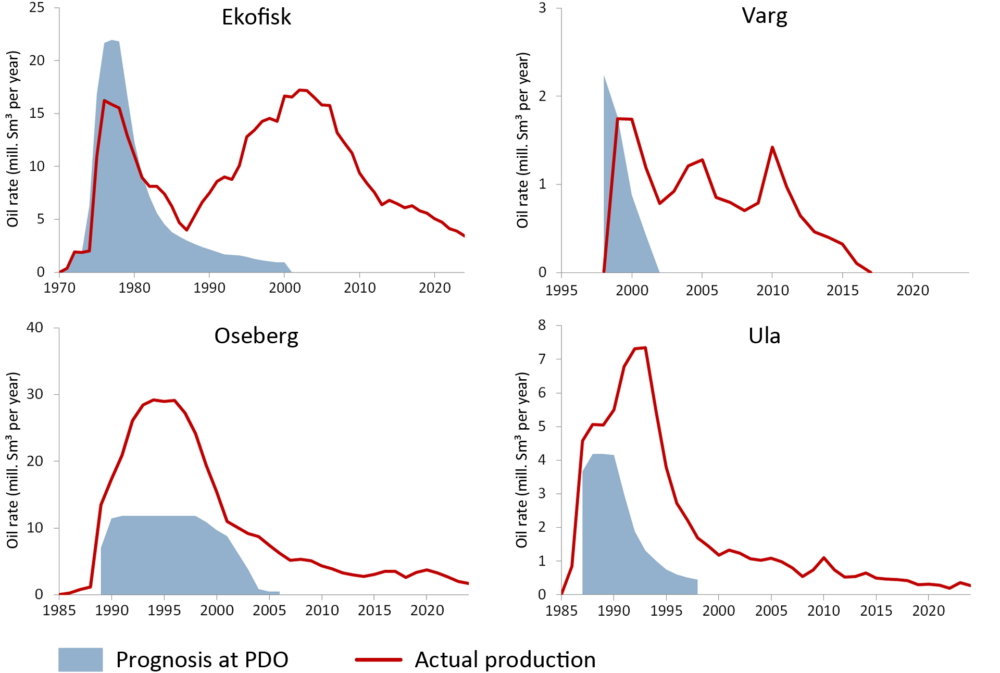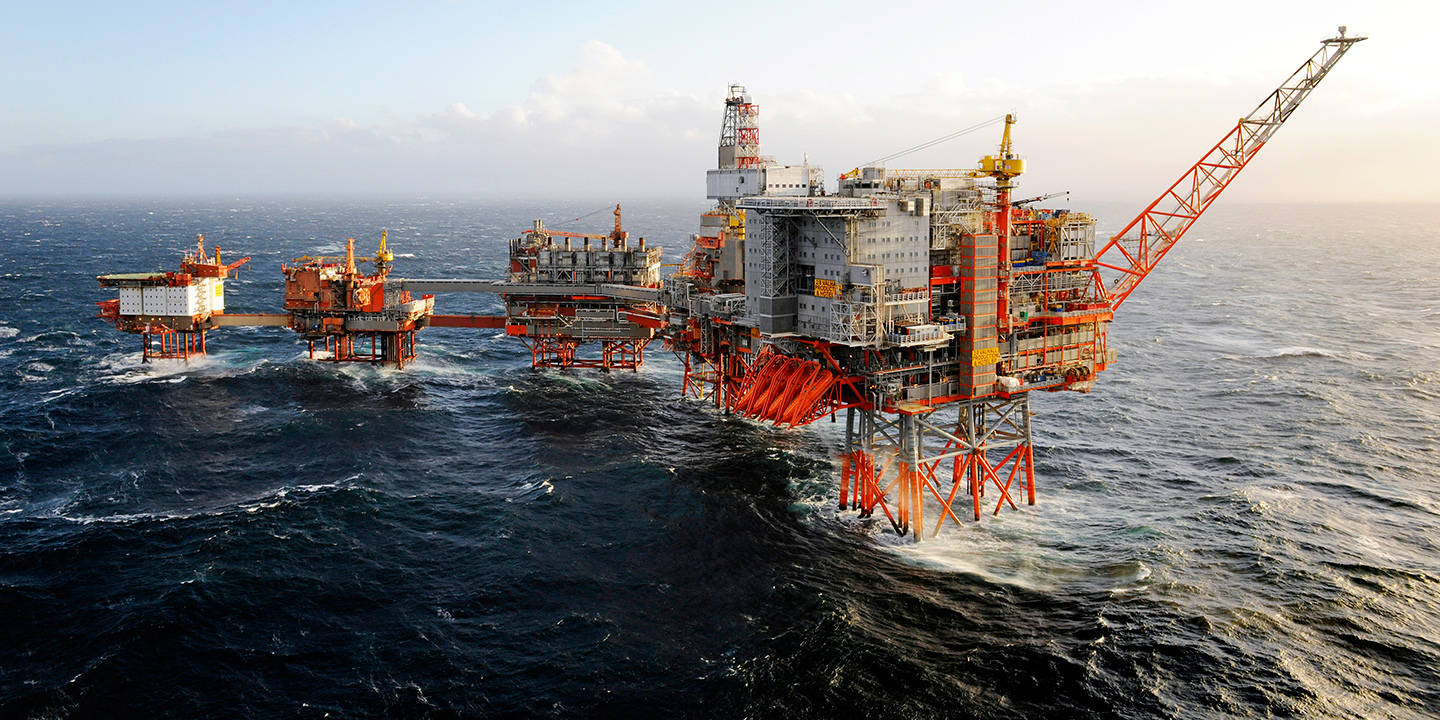To ensure sound long-term management of petroleum resources and consideration of other important public interests, the authorities have established a clear and predictable framework for development and operation. This includes requirements for operators to seek long-term, integrated and effective solutions at all stages from field development to decommissioning.
Major investments are being made to improve recovery from fields in production on the Norwegian shelf. This, combined with favourable geological conditions, means that the recovery rate on the Norwegian shelf is high compared with rates in other petroleum provinces. Moreover, new satellite discoveries are being tied in to infrastructure on existing fields, ensuring that the infrastructure is used efficiently and that the lifetime of the fields can be extended.
When operations have been closed down, the area must be cleared and the installations disposed of (made safe in place or removed).
The average oil recovery rate for oil fields on the Norwegian shelf is currently about 47 %, and the aim is to increase this further. However, recovery rates differ greatly from field to field, partly because reservoir conditions vary and different technical solutions are applied.
Significant oil resources will not be recovered using current technology and plans. About half of these resources require advanced methods, known as "Enhanced Oil Recovery" (EOR), in order to be produced. It is important that new EOR methods are tested, qualified and implemented on the Norwegian shelf within a reasonable period, to increase recovery and avoid loss of substantial oil volumes.
There is a huge potential for increased recovery from several fields on the Norwegian shelf. In cooperation with Imperial College in London, the Norwegian Offshore Directorate has studied the potential for improved recovery using EOR methods on the 46 largest oil fields and discoveries on the shelf. The conclusion of the analysis is that there is a considerable technical EOR potential of about 700 MSm3 of oil. This corresponds to almost as much oil as two Johan Sverdrup fields. A scaled EOR potential has also been computed by taking operational, financial and environmental factors into account when implementing EOR methods in fields. The scaled EOR potential, using given criteria, is calculated at approximately 350 MSm3 of oil.
For more details about the EOR screening study, see "The challenging barrels" in Norwegian Offshore Directorate's Resource Report 2019.
Distribution of oil reserves and resources for the largest oil fields as of 31 December 2024
Source: Norwegian Offshore Directorate
Print illustration Download data Distribution of oil reserves and resources for the largest oil fields as of 31 December 2024 Download PDF Download as image (PNG)
High Contrast Mode
The process of ensuring the highest possible recovery rate from a field starts when development is being planned and the facilities are being designed. Most oil fields on the Norwegian shelf incorporate pressure support in the form of water and/or gas injection from the time they come on stream. Constant improvements in technology for and knowledge about reservoir monitoring are making it possible to design better recovery strategies for the fields.
Systematic data acquisition and use of production and reservoir data increase understanding of reservoir properties throughout the production phase. An improved understanding of where oil and gas are located and their flow paths makes it possible to place wells more effectively. As new drilling targets are identified in this way, additional wells need to be drilled.
The steady improvement in understanding of reservoir properties throughout the production phase tends to result in considerable differences between the production forecast used in the original plan for development and operation (PDO) for a field and the volumes actually produced. The figure below shows the differences for selected fields on the Norwegian shelf.
Extended lifetime - production trends for Ekofisk, Varg, Oseberg and Ula
Source: Norwegian Offshore Directorate

The amount of oil that can be produced from a field is a function of factors including reservoir conditions, the development solution chosen, the production strategy and the available technology. It may be possible to extract oil not included in current production plans by using improved recovery methods. This oil can be divided into two categories – mobile and immobile.
Mobile oil can in principle be recovered using conventional production wells and techniques, by drilling additional wells and increasing the duration of water and/or gas injection.
Immobile oil adheres to the pore walls in the reservoir, and cannot be forced out of the pores and produced by water or gas injection. More advanced methods, known as enhanced recovery techniques, are needed to mobilise a proportion of the immobile oil.
According the the National Accounts, more than NOK 4 000 billion at the current monetary value has been invested on the Norwegian continental shelf. The infrastructure financed by these investments is used to produce and transport oil and gas and can also be used to produce further resources more cost effectively.
Exploration and development of resources close to existing infrastructure can result in substantial value creation for the Norwegian society. Declining production from a field releases infrastructure capacity, which can be used efficiently by tying in new resources to the same infrastructure.
In some cases, new smaller and surrounding deposits can only be profitably developed and produced by using existing infrastructure. These are sometimes known as time-critical resources, because they need to be produced before the existing infrastructure is phased out.

In order to promote the effective use of existing infrastructure, including platforms and pipelines, the Ministry of Energy adopted regulations relating to the use of facilities by others (the Third-party Access Regulations), which entered into force in 2006.
The objective of the regulations is to promote the efficient use of facilities and thereby provide incentives for licensees to conduct exploration and production activities close to existing infrastructure. To this end, they set out a framework for negotiations and for tariffs and conditions in agreements on the use of facilities by others. The regulations do not alter the principle that negotiating good solutions is the task of the commercial actors themselves.
Regulations of 20 December 2005 no. 1625 aim to ensure efficient use of the infrastructure and thereby give licensees good incentives to conduct exploration and production activities close to existing infrastructure.
The regulations provide a framework for the negotiation process between owner and user of the facilities, and for the formulation of tariffs and terms in agreements on others' use of facilities.
Disagreements that arise under the regulations can be brought to the Ministry of Energy for a decision, cf. section 13 of the regulations. The Ministry's decisions are being published on the Ministry's website (in Norwegian).
